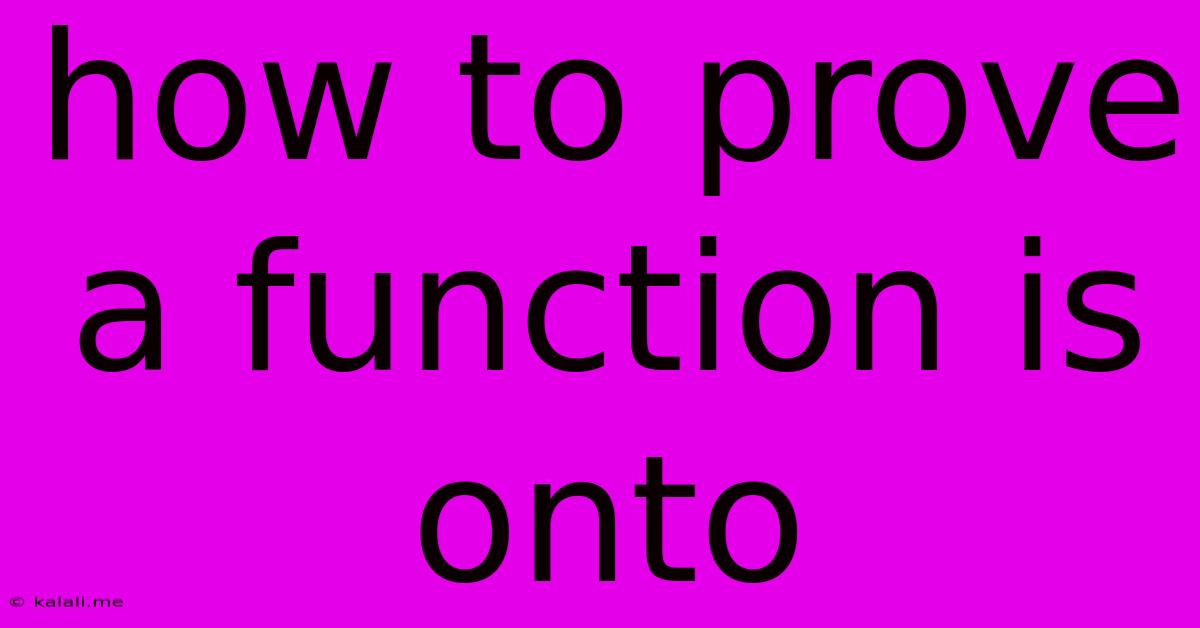How To Prove A Function Is Onto
Kalali
May 24, 2025 · 3 min read

Table of Contents
How to Prove a Function is Onto (Surjective)
This article will guide you through understanding and proving whether a function is onto, also known as surjective. Understanding onto functions is crucial in various areas of mathematics, including calculus, linear algebra, and discrete mathematics. This guide will equip you with the necessary tools and techniques to tackle these proofs effectively. We'll cover various approaches and illustrate them with examples.
What does it mean for a function to be onto?
A function f: A → B is onto (or surjective) if every element in the codomain B is mapped to by at least one element in the domain A. In simpler terms, for every element 'b' in B, there exists at least one element 'a' in A such that f(a) = b. The entire codomain is "covered" by the function's output. This contrasts with a one-to-one (injective) function, where each element in the codomain is mapped to by at most one element in the domain.
Methods for Proving a Function is Onto:
There are several ways to prove a function is onto. The best method depends on the specifics of the function and its domain and codomain.
1. Direct Proof:
This is the most straightforward approach. You need to show that for an arbitrary element 'b' in the codomain B, there exists an element 'a' in the domain A such that f(a) = b. This often involves solving an equation.
Example:
Prove that the function f: ℝ → ℝ defined by f(x) = 2x + 1 is onto.
Proof:
Let y be an arbitrary element in ℝ (the codomain). We need to find an x in ℝ (the domain) such that f(x) = y. We set up the equation:
2x + 1 = y
Solving for x:
x = (y - 1) / 2
Since y is a real number, (y - 1) / 2 is also a real number. Therefore, for every y in ℝ, there exists an x in ℝ (specifically, x = (y - 1) / 2) such that f(x) = y. Hence, f(x) is onto.
2. Proof by Cases:
If the domain or codomain has a specific structure (e.g., a set of integers partitioned into even and odd numbers), a proof by cases might be more efficient. You would show that every element in each case of the codomain is mapped to by at least one element in the domain.
3. Using the Definition Directly:
Sometimes, a direct application of the definition is the clearest and most concise approach, particularly for functions with simpler mappings. You explicitly show the existence of a pre-image for each element in the codomain.
4. Graphical Approach (for functions with simple domains and codomains):
For functions where the domain and codomain are easily visualized (e.g., subsets of real numbers), a graphical representation can be helpful. If every horizontal line intersects the graph of the function at least once, the function is onto. This approach is intuitive but less rigorous for formal proofs.
Common Mistakes to Avoid:
- Confusing onto with one-to-one: Remember, onto means every element in the codomain is mapped to, while one-to-one means each element in the codomain is mapped to by at most one element in the domain. A function can be onto without being one-to-one, and vice versa.
- Not considering the entire codomain: Ensure you've shown that every element in the codomain has a pre-image in the domain. Proving it for just a few elements is insufficient.
- Incorrect algebraic manipulations: When solving for x, be careful with algebraic steps and ensure the resulting x is always within the domain.
Conclusion:
Proving a function is onto requires a clear understanding of the definition and the ability to demonstrate the existence of a pre-image for every element in the codomain. By employing the appropriate proof techniques and carefully considering the specifics of the function, you can effectively demonstrate whether a function is surjective. Remember to always clearly state your assumptions, show your steps logically, and justify your conclusions. Practice with various examples to improve your proficiency in proving functions onto.
Latest Posts
Latest Posts
-
How Many Months Is A Hundred Days
Jul 18, 2025
-
Mother And I Or Mother And Me
Jul 18, 2025
-
How Many Oz In One Water Bottle
Jul 18, 2025
-
How Many Dimes In A 5 Roll
Jul 18, 2025
-
How Do You Say Basil In Spanish
Jul 18, 2025
Related Post
Thank you for visiting our website which covers about How To Prove A Function Is Onto . We hope the information provided has been useful to you. Feel free to contact us if you have any questions or need further assistance. See you next time and don't miss to bookmark.